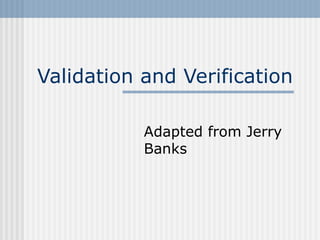Validation and verification
•Als PPT, PDF herunterladen•
14 gefällt mir•10,643 views
This presentation talks about the importance and techniques associated to validating and verifying models, more specifically simulation models.
Melden
Teilen
Melden
Teilen

Empfohlen
Empfohlen
Weitere ähnliche Inhalte
Was ist angesagt?
Was ist angesagt? (20)
introduction to modeling, Types of Models, Classification of mathematical mod...

introduction to modeling, Types of Models, Classification of mathematical mod...
Ähnlich wie Validation and verification
Ähnlich wie Validation and verification (20)
Data Analytics, Machine Learning, and HPC in Today’s Changing Application Env...

Data Analytics, Machine Learning, and HPC in Today’s Changing Application Env...
The Role Of The Sqa In Software Development By Jim Coleman

The Role Of The Sqa In Software Development By Jim Coleman
A Research Paper on BFO and PSO Based Movie Recommendation System | J4RV4I1016

A Research Paper on BFO and PSO Based Movie Recommendation System | J4RV4I1016
Mehr von De La Salle University-Manila
Mehr von De La Salle University-Manila (20)
Chapter3 general principles of discrete event simulation

Chapter3 general principles of discrete event simulation
Kürzlich hochgeladen
Kürzlich hochgeladen (20)
ICT Role in 21st Century Education & its Challenges.pptx

ICT Role in 21st Century Education & its Challenges.pptx
Basic Civil Engineering first year Notes- Chapter 4 Building.pptx

Basic Civil Engineering first year Notes- Chapter 4 Building.pptx
This PowerPoint helps students to consider the concept of infinity.

This PowerPoint helps students to consider the concept of infinity.
Mixin Classes in Odoo 17 How to Extend Models Using Mixin Classes

Mixin Classes in Odoo 17 How to Extend Models Using Mixin Classes
Seal of Good Local Governance (SGLG) 2024Final.pptx

Seal of Good Local Governance (SGLG) 2024Final.pptx
Asian American Pacific Islander Month DDSD 2024.pptx

Asian American Pacific Islander Month DDSD 2024.pptx
UGC NET Paper 1 Mathematical Reasoning & Aptitude.pdf

UGC NET Paper 1 Mathematical Reasoning & Aptitude.pdf
Micro-Scholarship, What it is, How can it help me.pdf

Micro-Scholarship, What it is, How can it help me.pdf
Validation and verification
- 1. Validation and Verification Adapted from Jerry Banks
- 2. Verification Concerned with building the model right Comparison of conceptual model and computer representation Is the model implemented correctly in the computer? Are the inputs and logical parameters represented properly?
- 3. Validation Concerned with building the right model Accurate representation of the real system This is achieved through the calibration of the model Iterative process until accuracy is acceptable
- 4. Model Building, Verification, and Validation REAL SYSTEM Conceptual Model 1Assumptions on system components 2Structural Assumptions (defines the interactions between the system components) 3Input parameters and data assumptions Operational Model (Computer Representation) Conceptual Validation Model Verification Calibration and Validation
- 5. Common sense suggestions for verification Have someone check the computerized model Make a flow diagram (with logical actions for each possible event) Examine model output for reasonableness Print the input parameters at the end of the simulation
- 6. Common sense suggestions for verification Make the computerized representation as self documenting as possible If animated, verify what is seen Use IRC or debuggers Use graphical interface
- 7. Three Classes of Techniques for Verification Common sense techniques Thorough documentation Traces
- 8. Calibration and Validation Validation is the overall process of comparing the model and its behavior to the real system and its behavior Calibration is the iterative process of comparing the model to the real system and making adjustments to the model, and so on.
- 9. Iterative Process of Calibration REAL SYSTEM Initial Model Second Revision of Model First Revision of Model Compare Model to Reality Compare Revised Model to Reality Compare second Revised Model to Reality
- 10. 3 Step Approach by Naylor and Finger (1967) Build a model with high face validity Validate model assumptions Compare the model input-output transformations to corresponding input-output transformations of the real system
- 11. Possible validation techniques in order of increasing cost-value ratio by Van Horn (1971) High face validity. Use previous research/ studies/observation/experience Conduct statistical test for data homogeneity, randomness, and goodness of fit test Conduct Turing test. Have a group of experts compare model output versus system output and detect the difference Compare model output to system output using statistical tests
- 12. Possible validation techniques in order of increasing cost-value ratio by Van Horn (1971) After model development, collect new data and apply previous 3 tests Build a new system or redesign the old one based on simulation results and use this data to validate the model Do little or no validation. Implement results without validating
